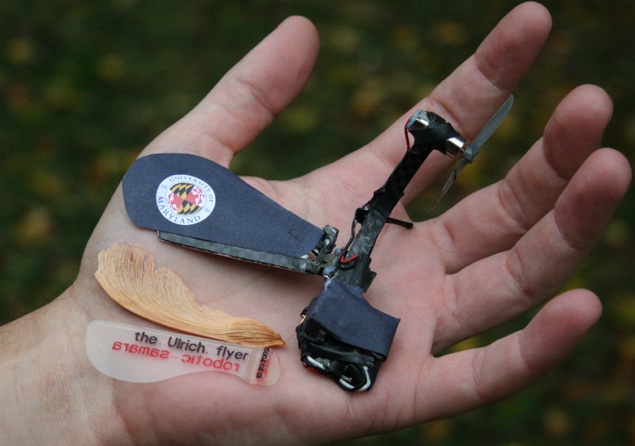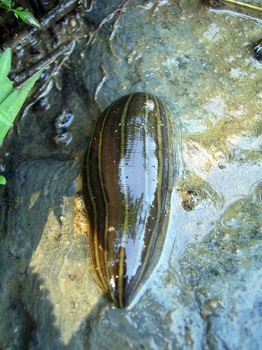The Latest from Boing Boing |  |
- Yahoo hires lap-dancers to entertain at its open, inclusive Hack Day event
- Voting machine source-code leak shows election-rigging subroutines?
- 86-year-old WWII vet on gay marriage: "what do you think I fought for in Omaha Beach?"
- Essential plot twists for writers
- BREATHE DEEP AND LET GO OF THINGS -- alternative to "Keep Calm and Carry On"
- Anvil Shooting: using explosives to fire anvils -- yes, ANVILS -- into the air
- Rare alternative version of Beatles track from White Album discovered
- Freakonomics Sequel Gets Climate Change Wrong
- Mexico: 'net advocates protest internet tax with #internetnecesario
- HOWTO make a Glenn Beck Diaper Halloween Mask
- What to do if you smell a terrorist
- 1953 cartoon about atomic energy
- Skiing robot
- Leech provides evidence to convict robber
- The Science of Autumn, Part the Second
- Tiny surveillance vehicle inspired by maple seed
- More bad news for Shepard Fairey: AP amends countersuit, claims purposeful deceit
- The boy who survived an accidental hot air balloon flight in 1964
- Geeky maternity t-shirts
- Nonsensical infographics
- 27" iMac rules Apple's new gear
- David Hockney's iPhone paintings
- Spurning the "false god of coffee"
- Chillits 2009 ambient music mixes online
- The Science of Autumn, Part the First
- Hilarious videos campaigning to hold British MPs to account for ripping off public with bogus expenses
- Digital Open Winners: From pocket-sized Altoids tin hack, big dreams emerge
- Biofuel Back to the Future
- Forensic Art: Finding missing kids with Photoshop
- Unfortunate Cookie: Random Vintage Weird Generator for All Your Procrastination Needs
| Yahoo hires lap-dancers to entertain at its open, inclusive Hack Day event Posted: 20 Oct 2009 11:35 PM PDT Yahoo has apologized for paying lap-dancers ("Hack Girls") to grind against attendees at its Hack Day Taiwan open event. For the second year running. Because, you know, it's the kind of thing that you can just accidentally do, hiring sex workers to come to your everyone's invited, inclusive Hack Day event. Two years in a row. What a blot on technology culture this is. As a father of a young daughter whom I hope will be excited about technology, hacking, and making stuff, Yahoo's vile behavior makes me want to puke purple exclamation points. For shame. Regrettable? I can think of some choice words to describe this, and regrettable is so far down the list that you'd need to scroll for a week to reach it. Love how this is all in the passive voice -- "the incident" is regrettable. As though it occurred in a vacuum, untouched by human hands. A kind of lightning strike of ghastly, stupid, boorish thoughtlessness. An act of God, perhaps. |
| Voting machine source-code leak shows election-rigging subroutines? Posted: 20 Oct 2009 11:24 PM PDT Sequouia, a company that makes many of the electronic voting machines used in the US and elsewhere, has inadvertently leaked much of the secret source-code that powers its systems. The first cut at analysis shows what looks like illegal election-rigging code ("code that appears to control or at least influence the logical flow of the election") in the source. Sequoia blew it on a public records response. We (basically EDA) have election databases from Riverside County that Sequoia insisted on "redacting" first, for which we paid cold cash. They appear instead to have just vandalized the data as valid databases by stripping the MS-SQL header data off, assuming that would stop us cold.Sequoia Voting Systems hacks self in foot (via MeFi) Previously:
|
| 86-year-old WWII vet on gay marriage: "what do you think I fought for in Omaha Beach?" Posted: 20 Oct 2009 10:18 PM PDT Darren sez, "A disarming video of an 86-year-old WWII veteran from a public meeting on Maine's marriage equality bill on April 22, 2009." Philip (Thanks, Darren!) |
| Essential plot twists for writers Posted: 20 Oct 2009 10:34 PM PDT  Ape Lad sez, "Dresden Codak, a very funny webcomic, has this handy chart of '42 Essential Third-Act Twists' for writers." 42 Essential 3rd Act Twists (Thanks, Ape Lad!) |
| BREATHE DEEP AND LET GO OF THINGS -- alternative to "Keep Calm and Carry On" Posted: 20 Oct 2009 10:33 PM PDT  Adam Greenfield's "Breathe Deep and Let Go of Things" tee is a nice variant on the classic WWII "Keep Calm and Carry On" posters that Adam Greenfield's "Breathe Deep and Let Go of Things" tee is a nice variant on the classic WWII "Keep Calm and Carry On" posters that It would make a good companion to Matt Jones's Get Excited and Make Things poster. Breathe deep and let go of things (via Die Puny Humans) Previously:
|
| Anvil Shooting: using explosives to fire anvils -- yes, ANVILS -- into the air Posted: 20 Oct 2009 09:54 PM PDT Comrades, I present to you the unheralded but noble sport of "anvil launching" in which a brave athlete puts a crapload of black powder between two anvils, lights a fuse and runs like the devil, then watches as the topmost anvil sails hundreds of feet into the air! Gay Wilkinson is the world champion anvil launcher and in this brief video, he demonstrates his grace and athleticism and total disregard for commonsense or safety. Gay, you are a credit to the sport. How to Shoot an Anvil 200 Feet in the Air (Thanks, Fipi Lele!) |
| Rare alternative version of Beatles track from White Album discovered Posted: 20 Oct 2009 09:16 PM PDT Above: A recently-discovered alternative version of the song "I Will" from The Beatles' White Album (1968), originally deemed too controversial to be included on the release. This rare track was remastered by audio engineer Peter Serafinowicz. |
| Freakonomics Sequel Gets Climate Change Wrong Posted: 20 Oct 2009 08:17 PM PDT The Freakonomics guys have apparently either really dropped the ball when it comes to understanding science, or they're willfully ignoring it. Either way, I'm pretty disappointed. The sequel's contrarian take on climate change--and the bad science it's steeped in--have been analyzed in exquisite detail by everybody from Paul Krugman, Berkeley economist J. Bradford DeLong, to the Union of Concerned Scientists, to various climate scientists spread hither and non about the Web. That's a lot of links, but they're there so you can go back and read page-by-page breakdowns of the mistakes and inaccuracies, by experts, if you want. I think that's important, because I know at least some of you are going to assume that any criticism of this book and its contents is all about some violation of pseudo-religious orthodoxy. I want you to be able to go see that this is about science. If you just want a quick summary, though, read on... There's a lot of stuff that the chapter on climate change gets wrong, but we can break it down into three key problems. First, Stephen Dubner and Steven Levitt argue that carbon dioxide isn't really the cause of climate change. It's not really "the bad guy". They cite Stanford climate scientist Ken Caldeira as supporting this, but Caldeira says what he actually told them was that carbon dioxide wasn't the only bad guy. And that's true. There are several gases in the greenhouse gas family and they're all a problem to varying degrees. But that doesn't mean that CO2 isn't a problem. (If you read the links, there's some journalism "Inside Baseball" about whether Dubner and Levitt knew they were misrepresenting Caldeira and, if not, what happened instead.) Second, they make the claim that the planet has actually been getting cooler for the last 10 years and, thus, climate change projections are wrong. That idea is based on data from a single study and is contradicted in others. Either way, short-term cooling doesn't invalidate a global warming trend. Why? Because global warming isn't a straight line going up. On a graph, this is a series of peaks and valleys. Close up, on the scale of decades, the trends appear to fluctuate up and down fairly randomly. Pull back and look at the last century, though, and there is clear upward movement. It doesn't really matter how hot or cold it was this year, or in 1999. What matters is what's happening, on a grand scale, between 1900 and 2009. (This link has the best in-depth explanation.) The last thing I'm going to talk about is Dubner and Levitt's assertion that geoengineering is a better way of dealing with climate change than any attempts to change energy use or sourcing. This one, I'm less well-versed in, particularly when it comes to the economics of such an endeavor. Although, the J. Bradford DeLong links provide some context. But let's put it this way: Geoengineering is cool, but it's a big risk. You're basically running a massive, one-time experiment and hoping the models caught all the possible consequences. Not saying it's evil. Not saying we won't maybe need to try something like that someday. But it's not exactly a first-line-of-defense kind of weapon. So, why do I care? Well, frankly, because I really enjoyed reading the original "Freakonomics" book. Dubner and Levitt are engaging writers, and they have a big audience. And that means they have a lot of influence. Part of me would like to ignore the problems with this new book, because it kind of comes across as an attention-grabbing ploy and I hate to bite the marketing stick. But, it's factually wrong. They're influential. And so their factual inaccuracies will enter into public debate as "fact". And so I feel the need to make a big, damn long post about it. |
| Mexico: 'net advocates protest internet tax with #internetnecesario Posted: 20 Oct 2009 06:37 PM PDT  Over the past two days, Internet advocates in Mexico have been voicing outrage over a proposed 3% telecommunications tax in a number of ways -- including flooding Twitter with the hashtag "internetnecesario," shorthand for "the internet is a basic neccesity." Here's one English language blog post from one blogger who believes the tax would be terrible news, and here is another in Spanish. Background on the politics in this Reuters item. (image via trendsmap.com, thanks @wordwardness). |
| HOWTO make a Glenn Beck Diaper Halloween Mask Posted: 20 Oct 2009 05:57 PM PDT  Just how would one construct a Glenn Beck Halloween Mask using little more than an adult diaper and a printout from these very internets? Ethan Persoff of "Comics With Problems" fame would be happy to show you how. WARNING: site contains disturbing images of Glenn Beck's face, and a photo of a fellow (not Glenn Beck) lying on a couch wearing nothing but a Glenn Beck Diaper Mask over his visage and yet another Glenn Beck Diaper over his manparts. WHICH OF THESE IMAGES IS MORE UNSETTLING? Why don't you tell me in the comments. Don't say I didn't warn you. Presenting the Glenn Beck Diaper Mask, Halloween 2009 (ep.tc) |
| What to do if you smell a terrorist Posted: 20 Oct 2009 04:21 PM PDT Do you smell a terrorist? Did you know that "terrorism is a crime?" This iWatch PSA stars a cast of pretend-earnest actors encouraging you to rat out your neighbor, "if you see, hear, or smell something suspicious." Don't hesitate -- "let law enforcement determine if it's a threat, (says this fellow, who plays a sex-crazed Mr Pringles when he's not playing a fear-mongering alarmist)" and "let the experts decide." Be sure to report on anyone drawing important buildings, a favorite tactic of terrorists with an artistic bent! Here's Fox News' pretend news story that explains iWatch. Do you recognize any of the other actors in this waste of money PSA? |
| 1953 cartoon about atomic energy Posted: 20 Oct 2009 02:17 PM PDT "A is for Atom" is a 1953 science cartoon with a snazzy soundtrack and a genially authoritative narrator. It's about 12 minutes long. A downloadable version of "A is for Atom" is available at Archive.org. |
| Posted: 20 Oct 2009 02:04 PM PDT Welcome to the uncanny mogul: Bojan Nemec at the Jožef Stefan Institute in Slovenia developed this skiing robot. It consists of two computing systems, one that acts as a vision and route planning system, and the other for stabilization and steering. Besides using it to make funny videos, they also plan to use it to test ski equipment and to build virtual reality models of the winter sport. |
| Leech provides evidence to convict robber Posted: 20 Oct 2009 01:45 PM PDT Eight years ago, police investigating the robbery of a 71-year-old Tasmian woman found a leech at the home. They took a blood sample from the leech and now have used DNA gleaned from the sample to convict Peter Alec Cannon of the crime. He has since admitted guilt. From the BBC News (Wikimedia Commons image): "Leech convicts Australian robber" (Thanks, Antinous!) |
| The Science of Autumn, Part the Second Posted: 20 Oct 2009 01:05 PM PDT Earlier today, we looked at why leaves change color--or, more specifically, why some trees change to red and some to yellow. Now, we turn our attention to the skies.  So, birds fly south for the Winter. But how do they pull off a trip like that, while you and I (or, maybe, just I) have no idea which way is north outside our hometowns? Actually, nobody knows for certain. But Matt Soniak at mental_floss has summarized three of the theories. My favorite: A particularly cool study showed that migratory birds also use "celestial navigation" to find their way around in the dark. Captive birds placed in a planetarium changed their directional orientation when the star pattern on the ceiling shifted and became confused when the images of stars were dimmed. The scientists conducting the experiment suggest that birds use the layout of constellations in the sky as a compass. I just like to imagine the phone calls between the bird guys, and the owner of the planetarium, both before and after the experiment. Previously: Image courtesy Flickr user Corey Leopold, via CC |
| Tiny surveillance vehicle inspired by maple seed Posted: 20 Oct 2009 12:53 PM PDT  Researchers have designed micro-unmanned aerial vehicle inspired by a maple seed. The University of Maryland engineers studied the spiral flight the seeds take when they fall from a tree and created what the university claims is the "world's smallest controllable single-winged rotocraft." Researchers have designed micro-unmanned aerial vehicle inspired by a maple seed. The University of Maryland engineers studied the spiral flight the seeds take when they fall from a tree and created what the university claims is the "world's smallest controllable single-winged rotocraft." In the 1950s, researchers first tried to create an unmanned aerial vehicle that could mimic a maple seed's spiraling fall. Ever since, their attempts have been foiled by instability, resulting in a lack of control over the tiny (less than one meter) vehicles, which were easily knocked off course by wind."Spiraling Flight of Maple Tree Seeds Inspires New Surveillance Technology" Previously: |
| More bad news for Shepard Fairey: AP amends countersuit, claims purposeful deceit Posted: 20 Oct 2009 01:13 PM PDT A new update in the legal battle over Shepard Fairey's iconic Obama poster, following Friday's surprise revelation by Fairey (BB post here) -- this time, no surprise: Today's AP release, in entirety, here. The federal court filing and related material are here. Previously: Legal battle over Shepard Fairey Obama poster takes an unexpected turn. |
| The boy who survived an accidental hot air balloon flight in 1964 Posted: 20 Oct 2009 12:15 PM PDT In response to the boy-in-a-hot-air-balloon fiasco of last week, SFGate has a story about a contractor in Marin who really did get whisked off by a hot air balloon 45 years ago. In 1964, (Dan) Nowell was a skinny 11-year-old who volunteered to help launch a hot air balloon in Mill Valley. But when the balloon abruptly lifted off, his fingers became entangled in the rope. As a horrified crowd of 200 spectators watched, the sixth-grader from Tamalpais Valley Elementary School was hoisted 3,000 feet into the air. ...As his feet flew off the ground, one of his father's friends grabbed his legs and tried pulling him down. The yank wasn't strong enough to bring the balloon back, but it did cinch the rope tightly around four fingers of his hand. ...Nowell says it hurt so much he was trying to reach his pocketknife, thinking he would cut the rope, even if it meant dropping from the sky.Lucky for Nowell, he was able to get the attention of the balloon's pilot (there was one, he was just unaware that there was a kid hanging from it) and he landed relatively safely on a nearby plum tree. There's a picture of him in mid-air here. Bay area's balloon boy scaled heights of fame |
| Posted: 20 Oct 2009 11:20 AM PDT  ThinkGeek has these fun maternity t-shirts perfect for parents who want their kids to be labeled as geeks even before they are born. I love the Loading... Please Wait design — unfortunately, the progress bar does not actually move. ThinkGeek ThinkGeek has these fun maternity t-shirts perfect for parents who want their kids to be labeled as geeks even before they are born. I love the Loading... Please Wait design — unfortunately, the progress bar does not actually move. ThinkGeek |
| Posted: 20 Oct 2009 11:11 AM PDT  As infographics, data visualizations, and charticles continue to be all the rage in magazines, I got a big kick out of designer Chad Hagen's series of "Nonsensical Infographics." All piss-taking aside, they're quite lovely too! Nonsensical Infographics (via Systems of Operation) |
| 27" iMac rules Apple's new gear Posted: 20 Oct 2009 10:56 AM PDT  The highlights of today's announcements are the Magic Mouse, a 27" iMac, and a Mac Mini designed to be used as a server. There's also a new plastic MacBook, for people who are allergic to aluminium. The new buttonless mouse is best summed up thusly: ZOMG. But this ZOMGness arises in large part by comparison to its dismal precedessors. Apple's mice have for at least a decade been its design blind spot--an ugly but usable Logitech is a common substitution in otherwise unsullied Mac setups--so this is a must-see item for anyone who cares about that sort of thing. Multitouch! Apple's new iMacs offer a 16:9 aspect ratio, 4GB of RAM as standard, terabyte hard drives and SD card slots. The 27" model is today's best of show: despite being about the same price as a 30" cinema display (which has the same horizontal resolution and 140 more lines) you get a decent all-in-one computer with the option of a gaming-ish-caliber Radeon HD 4850 video card. Furthermore, it has video-in, meaning it'll still be useful as a display after the system within falls into obsolescence. If only it had Blu-Ray and a TV tuner! The Mac Mini server drops the optical drive and gains dual 500GB hard drives: hello, redundant backups. Folks have quietly hankered for this for a long time, and its a popular hack. Now you can buy it off the shelf for $1,000, a good deal for the IT crowd considering the bundled OSX Server software, but way too steep for home users who just want a RAIDable storage box with real HTPC chops. Also announced today were better-performing routers and Time Capsules (Joel Johnson reports that buying a router from Apple is the final point where you've basically given it all up to them) and new aluminum remotes. As for the white MacBook, it has no SD card slot, no FireWire, and no budget price tag. Considering that its 13.3" metal sibling is the best mainstream laptop in existence, what's the point? Correct me, plastic fans. Press release [Apple] |
| David Hockney's iPhone paintings Posted: 20 Oct 2009 10:47 AM PDT   As Rob posted previously on BBG, famed painter David Hockney, 72, has become fascinated with the iPhone application Brushes. He's created nearly a thousand images and emails them out to his pals. In the current issue of the New York Review of Books, Lawrence Weshler talks to Hockney about his foray into his pet new media. From the New York Review of Books: Hockney, who has carried small notebooks in his pockets since his student days, along with pencils, crayons, pastel sticks, ink pens, and watercolor bottles--and smudged clean-up rags--is used to working small, but he delights in the simplicity of this new medium:"David Hockney's iPhone Passion" |
| Spurning the "false god of coffee" Posted: 20 Oct 2009 10:28 AM PDT  Robin Barooah gradually weaned himself off coffee and found that his concentration actually improved. He explains how he did it and what he discovered on the Quantified Self blog, which covers news about self-testing and self-monitoring. As part of a separate experiment, I have been keeping track of the amount of time I spend working on projects. I work in 25 minute intervals which I time with a coffee timer, and I mark an X in a paper journal for each interval that I successfully complete. If I get distracted, I don't mark the X, and if I can't concentrate, I abandon it and don't mark an X rather than sitting out the timer. I've been doing this since the end of June, so I tabulated the data and created a graph of my hours of concentration per day, and overlaid a bar showing when I drank my last coffee. |
| Chillits 2009 ambient music mixes online Posted: 20 Oct 2009 10:54 AM PDT  Chillits is an annual outdoor ambient music festival that takes place in the fall in the redwoods of Willits, California. I've never attended in person, but the DJs post their lovely musical sets online as MP3s and Torrents. This music keeps me calm all year, or tries anyway. I suggest starting with the sounds of DF Tram, but I'm biased. He's my favorite ambient DJ, spinning transgenre mixes inspired by and drawing from electronica, jazz, avant-garde classical, and the history of computer music. Chillits is an annual outdoor ambient music festival that takes place in the fall in the redwoods of Willits, California. I've never attended in person, but the DJs post their lovely musical sets online as MP3s and Torrents. This music keeps me calm all year, or tries anyway. I suggest starting with the sounds of DF Tram, but I'm biased. He's my favorite ambient DJ, spinning transgenre mixes inspired by and drawing from electronica, jazz, avant-garde classical, and the history of computer music.Chillits 2009 |
| The Science of Autumn, Part the First Posted: 20 Oct 2009 11:04 AM PDT  A couple of years ago, a botanist emailed Cory some nifty insights into why some leaves on a vine maple turn red and others yellow, and still others a mix of both. Go read that again first, then come back here, because it provides some good background information. Since then, it seems, scientists have been able to add to our understanding of leafy color change--particularly when it comes to answering the broader question of why some tree species tend toward yellow and why others tend toward red. One thing I'm curious about, after reading this, does Europe really have less red leaves in Autumn than the U.S.? I'd never heard that before... Image copyright John Bennett and licensed for reuse under this Creative Commons Licence |
| Posted: 20 Oct 2009 10:53 AM PDT Becky sez, openupnowdotorg's Channel (Thanks, Becky!) |
| Digital Open Winners: From pocket-sized Altoids tin hack, big dreams emerge Posted: 20 Oct 2009 01:13 PM PDT (Download MP4 video or Watch on YouTube, or view with subtitles on Dotsub). Institute for the Future teamed up with Sun Microsystems and Boing Boing Video to co-host the Digital Open, an online tech expo for teens 17 and under around the world. In this video, you'll meet awesome 16 year old Nick Brenn. His crafty Altoids tin hacks led to a winning "Electronikits" project for the Digital Open, which sells electronics kits for pocket-sized tin-mod flashlights and other DIY oddities. I loved his answer to the "Who is this project for?" part of the Digital Open Questionnaire: "Anyone with a passion for being a DIY-er and a fiend for building cool projects. Who wouldn't want a sweet Altoids LED Flashlight? You could have the freshest flashlight on the block! Or an Altoids night-light! It is rare to find someone with such cool projects as you would have!" Nick tells us more about how "Electronikits" came to be, below and after the jump:
I created my business known as NGB Enterprises. To sell to Edmunds, I needed a tax i.d, and since I was a minor, I created a "dba" (doing business as), under my mom's business. So in just months, I had established a business based on instructions I submitted that could be viewed by the whole world! So I then bought the necessary components for the kits that Edmunds wanted to buy, and I shipped them out to the company. I was paid, I had a profit and life was good! I wanted to keep this going, and I did not want this to be a one time thing. So in order to keep with "openness," I did not take down the instructions that I posted on the Instructables website, because I was confident that I did not have to worry about anyone trying to do something silly with my work, and I used those instructions for my kits.  Read more of Nick's story here, with links to features about his projects at HowStuffWorks and other science-y sites. Read more about the youth competition in IFTF's press release announcing Digital Open winners. Previously:
|
| Posted: 20 Oct 2009 09:10 AM PDT A century ago, farmers relied on these big, steampunk-y contraptions called threshing machines to bring in the harvest. The machines were portable, and expensive--they were usually owned by a third party, or by a cooperative of farmers. The threshers traveled from farm to farm, region to region, separating grain from stalk and turning crops into commodities.  Pictured: This threshing machine's body lies a mouldering in a barn, but its spirit is marching on. From Flickr user exfordy, via CC. Now, researchers from the University of Minnesota are hoping to repeat history with a portable machine that could turn prairie grasses, small trees and corn stalks into liquid biofuel. It's a nifty idea that could be great for both the environment and rural economies...provided the boys in the back room can work out a few bugs. Portable microwave pyrolysis could be the future's answer to the threshing machine. Obviously, what's being made is different, but the basic idea is the same: Take this big machine around from farm to farm and use it to help farmers turn plants into a higher-profit product.  Pictured: A higher-profit product. Pyrolysis is all about using heat to break down organic materials into a form better suited to usable, commercial energy. To get things cooking, the University's system relies on microwaves, stronger versions of the same technology you use to make popcorn and heat up leftover pizza. It's a handy, and somewhat outside-the-box, approach. Typically, before any material is put into a pyrolysis system, it has to be ground into tiny pieces to improve the transfer of heat through the mass. But as you may have noticed, microwaves heat up the center of a solid object just fine. If you're cooking on the stove, it saves time to break a chicken breast into smaller chunks. But microwave that breast whole, and the center cooks at about the same rate as the outside. Same principal applies here. Using a well-established technology like microwaves also means the University's pyrolysis set-up could, potentially, produce fuel for less upfront cost compared to typical pyrolysis systems, and some of the other biofuel-making methods. The main product of the University's system is a liquid fuel. It does produce enough combustible syngas that, once started, it can power itself. But, in general, liquid is what comes out. On one hand, this is a bit limiting. Other methods of breaking down organic material focus on producing just the syngas, a veritable chemistry Christmas present of hydrogen and carbon monoxide. Syngas can be burned like natural gas. You can use it to make certain chemicals that normally have to be derived from fossil fuels, like the ones used in agricultural fertilizers. Or you can turn it into a liquid fuel. Whatever you want. If alternative fuel production were baking, syngas would be the water and flour. The liquid fuel produced by pyrolysis, on the other hand, is more like ending up with cupcake batter. Still nice, but you'll only be making dessert. On the other hand, if you really want cake, microwave pyrolysis gets you to that endpoint in fewer steps. But biogas also needs some cleaning up. An engine will run on fresh biogas, but over time the acidic fuel will tear it apart. Paul Chen, senior research associate in the Department of Bioproducts and Biosystems Engineering, is one of the researchers working on the University of Minnesota microwave pyrolysis system. He says his team is working with chemical catalysts that can make biogas more engine-friendly, but they're still trying to figure out the best way to tackle the problem. Another kink that still needs to be worked out in the portable pyrolysis plan: The whole "portable" part.  Pictured: Not a portable system. Right now, the University's machine is a Rube Goldberg-like mass of conveyors and pipes that stands almost two stories tall with a floorplate that would fill a three-car garage. It is innovative, but it's not quite ready to load on a truck. Chen and company say they're close to working out a design for a smaller pyrolysis system they could take on the road. Armed with a $500,000 grant, they hope to have the pilot version built by early next year. If it works, the system could give farmers a relatively easy way to produce fuel for use on their own farms or, if it traveled with a tanker truck, that they could sell through local farming cooperatives, which already have a license to sell and ship fuel. |
| Forensic Art: Finding missing kids with Photoshop Posted: 20 Oct 2009 03:00 PM PDT  According to the US Department of Justice, over 2,000 children are reported missing every day. And while most of them don't stay missing for that long, it's a terrifying experience for any parent or guardian to go through. For the past quarter century, the National Center for Missing and Exploited Children, a private non-profit established by Congress, has acted as a resource for people who have lost a child. One of cool things the Center does is age progression — the creation of computer rendered images that show what a child might look like now. We saw this most recently with the horrible case of Jaycee Dugard, who was kidnapped in 1991 by a sick criminal who kept her captive and raped her for 18 years. Last week, People Magazine revealed the first real photo of Dugard at her current age, and it was strikingly similar to the age progressed photo that the NCMEC had created. The NCMEC has a 97% recovery rate of all missing children reported to it, with over 900 safely returned children whose age progressed photos were advertised on TV and on milk cartons. So how do they do it? Turns out there's a small team of retired forensic detectives using Photoshop and fine art skills to re-imagine what these children might look like as they grow older. According to the US Department of Justice, over 2,000 children are reported missing every day. And while most of them don't stay missing for that long, it's a terrifying experience for any parent or guardian to go through. For the past quarter century, the National Center for Missing and Exploited Children, a private non-profit established by Congress, has acted as a resource for people who have lost a child. One of cool things the Center does is age progression — the creation of computer rendered images that show what a child might look like now. We saw this most recently with the horrible case of Jaycee Dugard, who was kidnapped in 1991 by a sick criminal who kept her captive and raped her for 18 years. Last week, People Magazine revealed the first real photo of Dugard at her current age, and it was strikingly similar to the age progressed photo that the NCMEC had created. The NCMEC has a 97% recovery rate of all missing children reported to it, with over 900 safely returned children whose age progressed photos were advertised on TV and on milk cartons. So how do they do it? Turns out there's a small team of retired forensic detectives using Photoshop and fine art skills to re-imagine what these children might look like as they grow older.  Joseph Carson was abducted by his non-custodial dad as a toddler and was missing for about five years when a customer at an auto parts store saw that a PSA showing his age progressed image was strikingly similar to a kid who just happened to be in the store at that exact time. Glen Miller, NCMEC: Joseph Carson was abducted by his non-custodial dad as a toddler and was missing for about five years when a customer at an auto parts store saw that a PSA showing his age progressed image was strikingly similar to a kid who just happened to be in the store at that exact time. Glen Miller, NCMEC:I supervise the forensic imaging unit here at the National Center for Missing and Exploited Children. I'm a retired police forensic artist — I've been here since 1992. As a detective in the police force, I often created composites from witness memories of bank robbers and rapists. Here at the Center, the emphasis is on aging faces of long-term missing children. It's different than working from memory, but there isn't a software available that automatically ages photos. When a child goes missing, we usually get a photo with the report. As time goes on, though, the photo becomes less and less valuable, especially if the child was very young when he went missing. That's where age progression comes in. To come up with the best possible progressed image, we begin with a photo of the child and of the biological parent &mdash the father if it's a little boy, the mother at if it's a girl — at the age that the child would now be. My colleague Joe Mullins worked on the most recent image of Jaycee. He had to study 11-year old Jaycee's face closely, and become familiar with all her unique features — the eyes, the eyelids, the shape of the nose. 80% of likeness is recognizable in the eyes. We're constantly dealing with the subtleties of aging. What makes someone appear 15 and not 29? He battled that while holding onto the unique facial qualities that set Jaycee apart.  When Jonathan Ortiz was just two years old, his mom ran off with him to Guadalajara Mexico, after attempting to kill his dad by feeding him a milkshake laced with pesticide. She was arrested and extradited back to the US eight years later, but Jonathan wasn't with her. Here, you can see that the age progressed image of 10-year old Jonathan (middle) created from a photo of him as a one-year old is quite similar to the actual photo taken (far left) when he was found — especially around the mouth. When Jonathan Ortiz was just two years old, his mom ran off with him to Guadalajara Mexico, after attempting to kill his dad by feeding him a milkshake laced with pesticide. She was arrested and extradited back to the US eight years later, but Jonathan wasn't with her. Here, you can see that the age progressed image of 10-year old Jonathan (middle) created from a photo of him as a one-year old is quite similar to the actual photo taken (far left) when he was found — especially around the mouth. We use Adobe Photoshop CS4 to manipulate the photos. We stretch the face to approximate growth, blend it with parental photos, and put a hairstyle on each child. The clothes are transformed to be more appropriate for that age. We use powerful Macs with lots of memory and speed, and drawing tablets instead of mouses. With this technology, we can complete one age progression in about three hours. When we look at the child's face and family photos, we pretty much know what we're going to do with it right away. We try to do an age progression every two years until age 18, and then every five years after that. We continue to age progress children unless we're specifically told not to or until the child is located. Last quarter, we produced 131 age progressions. I enjoy seeing the transformation as I manipulate the photos. We build faces in virtual environments for people to recognize, but the only way we really know we're successful is by having results. We can compliment each other on how great an age progressed image is, but the public is the true test of success. To say we love feedback is an understatement. We crave it. It encourages parents of long term missing kids that there's hope, and that's one of the most important things about what we do. We're giving people their identity back. Previously: |
| Unfortunate Cookie: Random Vintage Weird Generator for All Your Procrastination Needs Posted: 20 Oct 2009 08:27 AM PDT Footnote.com collects 59,818,947 (Why yes, that is a very exact number, isn't it?) scanned historical documents, from places like the National Archives and Library of Congress. But that can be a little overwhelming when you don't have a specific item you're trying to find. Enter "Unfortunate Cookie", Footnote.com's random document generator that pulls up some great, eye-catching news headlines (and full stories) from decades past, such as: I'll confess, I'm not sure why the site includes a fortune cookie theme, the documents are interesting enough without it. But in general, it's a great (and quickly addictive) peek into the past. Previously: |
| You are subscribed to email updates from Boing Boing To stop receiving these emails, you may unsubscribe now. | Email delivery powered by Google |
| Google Inc., 20 West Kinzie, Chicago IL USA 60610 | |

 I wanted to acknowledge the public reaction generated by the images of female dancers at our Taiwan Open Hack Day this past weekend. Our hack events are designed to give developers an opportunity to learn about our APIs and technologies. As many folks have rightly pointed out, the "Hack Girls" aspect of our Taiwan Hack Day is not reflective of that spirit or purpose. And it's certainly not the message we want to send about our values here at Yahoo!. Hack Days are about making everyone feel welcome, including women coders and technologists.
I wanted to acknowledge the public reaction generated by the images of female dancers at our Taiwan Open Hack Day this past weekend. Our hack events are designed to give developers an opportunity to learn about our APIs and technologies. As many folks have rightly pointed out, the "Hack Girls" aspect of our Taiwan Hack Day is not reflective of that spirit or purpose. And it's certainly not the message we want to send about our values here at Yahoo!. Hack Days are about making everyone feel welcome, including women coders and technologists.  This incident is regrettable and we apologize to anyone that we have offended. Rest assured, it won't happen again.
This incident is regrettable and we apologize to anyone that we have offended. Rest assured, it won't happen again. 

 The Associated Press today filed a motion seeking to amend its Answer, Affirmative Defenses and Counterclaims from last March in the lawsuit filed against the news cooperative by Shepard Fairey and Obey Giant Art, Inc., based on Fairey's recent revelations that he fabricated and destroyed, or attempted to destroy relevant evidence and other newly discovered information in the lawsuit. The AP disputes Fairey's most recent allegations that he made a "mistake" about which AP photo he used to create the Obama Hope poster, saying such allegations are "simply not credible."
The Associated Press today filed a motion seeking to amend its Answer, Affirmative Defenses and Counterclaims from last March in the lawsuit filed against the news cooperative by Shepard Fairey and Obey Giant Art, Inc., based on Fairey's recent revelations that he fabricated and destroyed, or attempted to destroy relevant evidence and other newly discovered information in the lawsuit. The AP disputes Fairey's most recent allegations that he made a "mistake" about which AP photo he used to create the Obama Hope poster, saying such allegations are "simply not credible." It all started with instructions that I posted on
It all started with instructions that I posted on
No comments:
Post a Comment